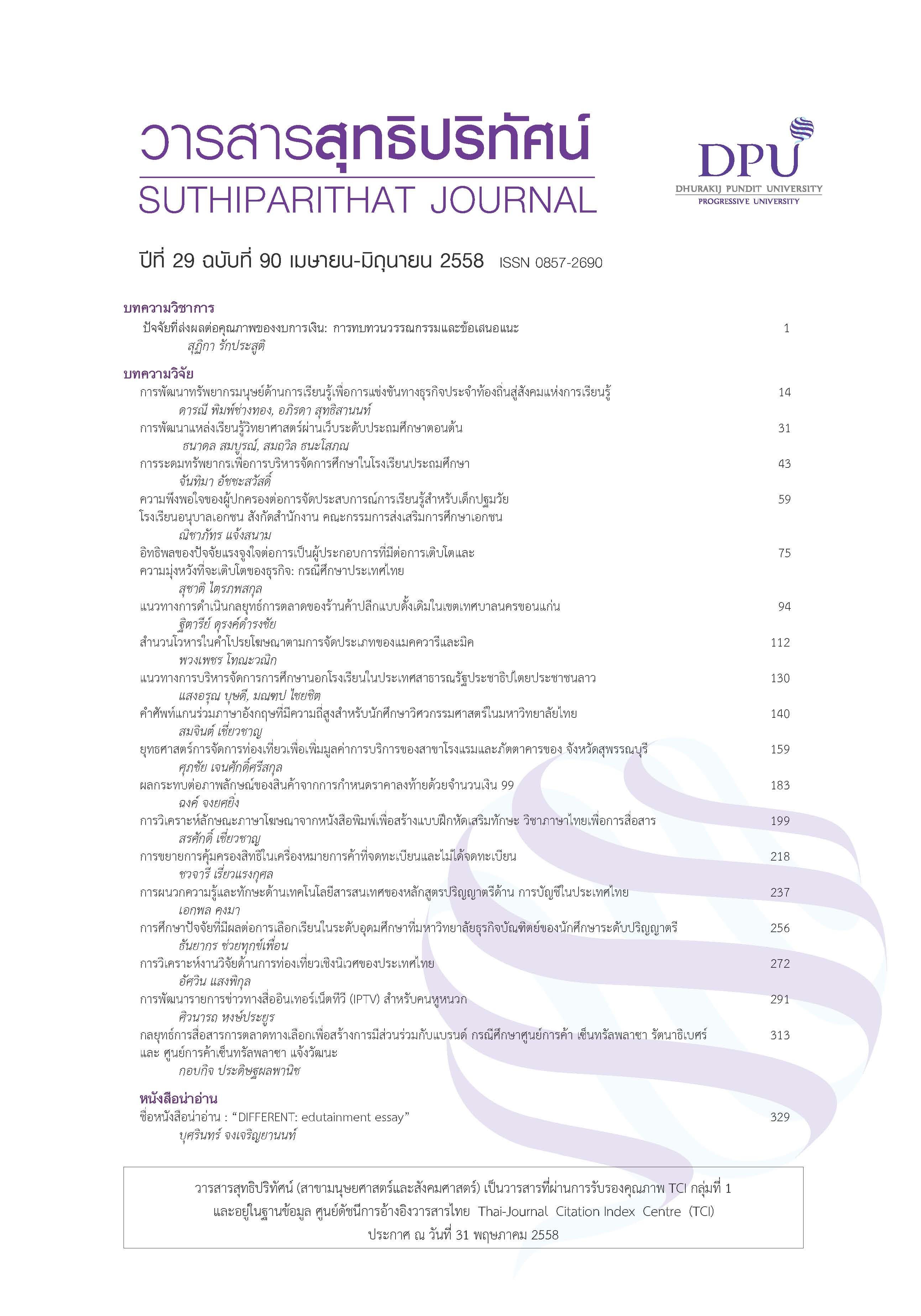อิทธิพลของปัจจัยแรงจูงใจต่อการเป็นผู้ประกอบการที่มีต่อการเติบโตและความมุ่งหวังที่จะเติบโตของธุรกิจ: กรณีศึกษาประเทศไทย
คำสำคัญ:
แรงจูงใจต่อการเป็นผู้ประกอบการ, การเติบโตของธุรกิจ, ครงการศึกษาสังคมความเป็นผู้ประกอบการระดับโลกประเทศไทยบทคัดย่อ
การวิจัยครั้งนี้มีวัตถุประสงค์เพื่อศึกษาอิทธิพลของปัจจัยแรงจูงใจต่อการเป็นผู้ประกอบการที่มีต่อการเติบโตของธุรกิจกับกลุ่มตัวอย่าง ซึ่งเป็นประชากรไทยที่มีส่วนร่วมกับกิจกรรมผู้ประกอบการ จำนวนทั้งสิ้น 728 ตัวอย่างโดยอาศัยข้อมูลจากการสำรวจโครงการศึกษาสังคมความเป็นผู้ประกอบการระดับโลก ในปี พ.ศ. 2556 ซึ่งมีการเก็บข้อมูลด้วยวิธีการสุ่มตัวอย่างแบบหลาย ขั้นตอนใน 6 ภูมิภาคทั่วประเทศไทย และทำการเก็บรวบรวมข้อมูลโดยการใช้แบบสอบถามเป็นเครื่องมือวิจัย ผลการวิเคราะห์ข้อมูลด้วยการทดสอบความแตกต่างของค่าเฉลี่ยโดยใช้ Independent sample t-test และการวิเคราะห์สมการถดถอยพหุคูณเชิงเส้นตรง พบว่า ผู้ประกอบการที่ทำธุรกิจเพราะมองเห็นโอกาสมีการเติบโตของธุรกิจมากกว่าผู้ประกอบการที่ทำธุรกิจเพราะความจำเป็นอย่างมีนัยสำคัญทางสถิติ และผู้ประกอบการที่ทำธุรกิจเพราะมองเห็นโอกาสมีความมุ่งหวังการเติบโตของ ธุรกิจในอนาคตมากกว่าผู้ประกอบการที่ทำธุรกิจเพราะความจำเป็นอย่างมีนัยสำคัญทางสถิติ
เอกสารอ้างอิง
สำนักงานส่งเสริมวิสาหกิจขนาดกลางและขนาดย่อม. (2558). ส่วนที่ 01: สถานการณ์และตัวชี้วัดเชิงเศรษฐกิจของ SMEs ปี 2556 และปี 2557. สืบค้นเมื่อ 1 พฤษภาคม 2558, จาก http://www.sme.go.th/th/index.php/data-alert/alert/report-smes-year/report-year/report-year-2557
Audretsch, D. B., Keilbach, M. C., & Lehmann, E. E. (2006). Entrepreneurship and Economic Growth. Oxford: Oxford University Press.
Bergmann, H., & Sternberg, R. (2007).The Changing Face of Entrepreneurship in Germany.Small Business Economics, 28(2-3), 205-221.
Bhola, R., Verheul, I., Thurik, A., & Grilo, I. (2006).Explaining engagement levels of opportunity and necessity entrepreneurs.EIM Business and Policy Research. Retrieved 26 April, 2015 from http://www.entrepreneurship-sme.eu/pdf-ez/H200610.pdf
Block, J., & Sandner, P. (2009). Necessity and Opportunity Entrepreneurs and Their Duration in Self-employment: Evidence from German Micro Data. Journal of Industry, Competition and Trade, 9(2), 117-137.
Block, J. H., & Wagner, M. (2007, August). Opportunity Recognition and Exploitation by necessity and Opportunity Entrepreneurs: Empirical Evidence from Earnings Equations. In Academy of Management Proceedings, 2007(1), 1-6. Academy of Management.
Borgas, C., Filion, L. J., & Simard, G. (2008, June). Specificities of the Venture Creation Process by Women. In Proceedings of the Annual Conference of the ICSB/CIPE, Halifax, Nouvelle Ecosse, Canada.
Bosma, N., Wennekers, S., & Amorós, J.E. (2012). Global Entrepreneurship Monitor 2011 Extended Report. Babson College, Universidad delDesarrollo, UniversitiTun Abdul Razak: Wellesley MA, Santiago Chile, Kuala Lumpur, Malaysia.
Brinckmann, J. (2008). Functional management competence and growth of young technology based firms. Creativity and Innovation Management, 17(3), 186-203.
Buttner, E., H., & Moore, D., P. (1997). Women’s Organizational Exodus to Entrepreneurship: Self-reported Motivations and Correlates with Success. Journal of Small Business Management, 35(1), 34-46.
Georgellis, Y., & Wall, H. (2005). Gender differences in self employment.International Review of Applied Economics, 19(3), 321-342.
Hamilton, R., T., & Lawrence, L. (2001).Explaining size differences in smaller firms. International Small Business Journal, 19(2), 49-60.
Harding, R., Brooksbank, D., Hart, M., Jones-Evans, D., Levie, J., O’Reilly, J., & Walker, J. (2006).Global Entrepreneurship Monitor – United Kingdom 2005. London: London Business School.
Kirkwood, J., & Campbell-Hunt, C. (2006, June). Beyond Push and Pull Factors: Exploring the Process of How Women and Men Decide to Become Entrepreneurs. Proceedings of the 51st World Conference of the ICSB, Melbourne, Australia: Melbourne University Press.
Langowitz, N., & Minniti, M. (2007).The Entrepreneurial Propensity of Women. Entrepreneurship Theory and Practice, 31(3), 341-360.
Manolova, T., S., Brush, G.,B., & Edelman, L., F. (2008). What do woman entrepreneurs want?.Strategic Change, 17, 69-82.
Mason, G., Bishop, K., & Robinson, C. (2009). Business growth and innovation: The wider impact of rapidly growing firms in UK city-regions. London: NESTA.
McClelland, E., & Swail, J. (2005).Following the Pathway of Female Entrepreneurs. International Journal of Entrepreneurial Behaviour and Research, 11(2), 87-107.
McKelvie, A., & Wiklund, J. (2010, May).Advancing firm growth research: A focus on growth mode instead of growth rate.Invited presentation at Lund University. Sweden.
Orser, B., J., Riding, A., L., & Manley, K. (2006).Women Entrepreneurs and Financial Capital.Entrepreneurs Theory and Practice, 30(5), 643-661.
Reynolds, P., D., Bygrave, W., D., Autio, E., Cox, L., W., & Hay, M. (2002). Global Entrepreneurship Monitor, 2002 Executive Report.Babson College, Ewing Marion Kauffman Foundation and London Business School. Boston: Corwin Press.
Reynolds, P.D., Bosma, N., Autio, E., Hunt, S., De Bono, N., & Servais, I. (2005). Global Entrepreneurship Monitor: Data Collection Design and Implementation: 1998–2003. Small Business Economics, 24(3), 205- 231.
Smallbone, D., & Wyer, P. (2000).Growth and development in the small firm, in Carter, S. and James-Evans, D. (Eds), Enterprise and Small Business, Prentice Hall, Harlow. New Jersey: Pearson Education.
Smith-Hunter, A., Joanne, K., & Virginia, Y. (2003).A psychological model of entrepreneurial behavior.Journal of the Academy of Business and Economics, 2(2), 180-192.
Van Praag, M. (2001).Business Survival and Success of Young Small Business Owners: an empirical analysis. Retrieved 26 April, 2015 from http://papers.tinbergen.nl/03050.pdf
Vivarelli, M. (2004). Are all the potential entrepreneurs so good?.Small Business Economics, 23, 41-49.
Wiklund, L., & Shepherd, D. (2003). Aspiring for, and achieving growth: the moderating role of resources and opportunities. Journal of Management Studies, 40(8), 1919-1941.
Yang, C.H., & Huang, C., H. (2005).R&D, size and firm growth in Taiwan’s electronics industry.Small Business Economics, 25(5), 477-487.
Yasuda, T. (2005).Firm growth, size and behavior in Japanese manufacturing. Small Business Economics, 24(1), 1-15. Translated Thai References
OSMEP. (2015). The white paper on small and medium enterprises of Thailand in 2014. Office of Small and Medium Enterprises Promotion (OSMEP), Bangkok, Thailand.
ดาวน์โหลด
เผยแพร่แล้ว
รูปแบบการอ้างอิง
ฉบับ
ประเภทบทความ
สัญญาอนุญาต
เนื้อหาและข้อมูลในบทความที่ลงตีพิมพ์ในวารสารสุทธิปริทัศน์ ถือเป็นข้อคิดเห็นและความรับผิดชอบของผู้เขียนบทความโดยตรงซึ่งกองบรรณาธิการวารสาร ไม่จำเป็นต้องเห็นด้วย หรือร่วมรับผิดชอบใด ๆ
บทความ ข้อมูล เนื้อหา รูปภาพ ฯลฯ ที่ได้รับการตีพิมพ์ในวารสารสุทธิปริทัศน์ ถือเป็นลิขสิทธิ์ของวารสารสุทธิปริทัศน์หากบุคคลหรือหน่วยงานใดต้องการนำทั้งหมดหรือส่วนหนึ่งส่วนใดไปเผยแพร่ต่อหรือเพื่อกระทำการใด ๆ จะต้องได้รับอนุญาตเป็นลายลักษณ์อักษรจากวารสารสุทธิปริทัศน์ก่อนเท่านั้น







